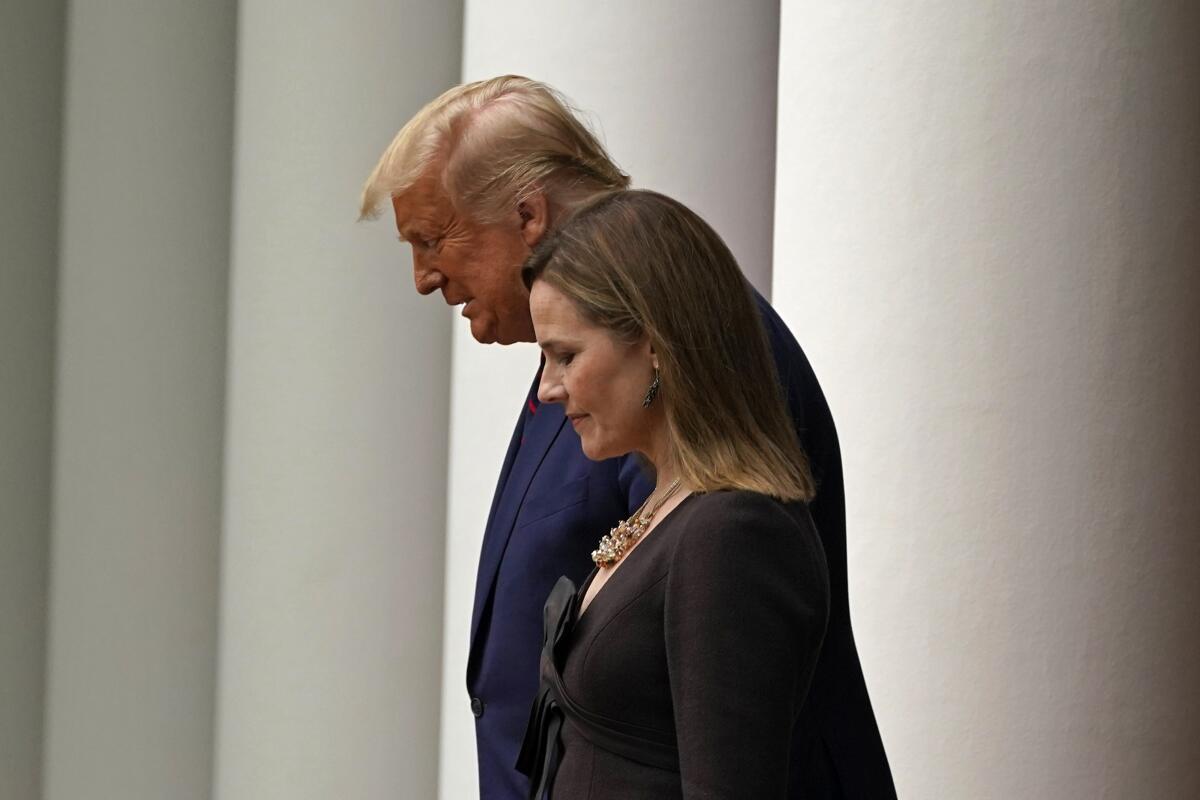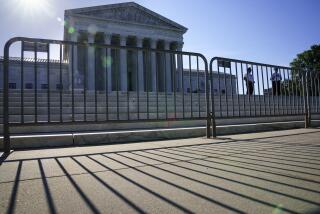Column: A lopsided Supreme Court harms the country and its own legitimacy

- Share via
Amy Coney Barrett is an impressive Supreme Court nominee. Even in the rarefied circle of her peers, she is a sharp and deep thinker. Her academic and judicial writing is always solid and sometimes luminous. She wins universal praise from former students and colleagues for the personal qualities — calmness, reasonableness, good cheer — that make up judicial temperament.
The well-respected and self-described liberal Harvard law professor Noah Feldman, for example, called her “highly qualified.” He clerked with her on the court two decades ago. “I know her to be a brilliant and conscientious lawyer,” he wrote in a column, “who will analyze and decide cases in good faith.”
Yet Barrett shouldn’t be confirmed as a Supreme Court justice. It would be bad for the court and bad for the country.
Barrett’s ascent would cement a five-person majority carefully culled from among the most dogmatically conservative legal minds in the country. They are all, to one degree or another, members of a legal movement defined by its antipathy to scores of legal precedents from the last 70 years and by its determination to move the law sharply right.
Together, those five — Barrett, Neil Gorsuch, Brett Kavanaugh, Clarence Thomas and Samuel Alito — would make for a starkly lopsided court not just because a set of likeminded judges will have a hammerlock on outcomes but because they self-consciously inhabit the far-right margin of the legal profession, the legal academy and society’s thinking.
So what, you might think. Their views may be universally narrow and conservative, but that doesn’t make them wrong. And in any event, if judges behave as Barrett described in the Rose Garden last Saturday — resolutely “setting aside any policy views they might hold” to apply the law “as it is written” — how big a difference does the appointment of another like-minded hard-right justice make?
Plenty. And everyone knows it. It’s not that the law is infinitely malleable or just a proxy for political ideas; there are right legal answers. But finding them is far less straightforward than applying the law “as it is written.”
Justice Robert H. Jackson, appointed to the court by Franklin Roosevelt, famously wrote of the court, “We are not final because we are infallible, but we are infallible only because we are final.” A corollary of Jackson’s adage is that the Supreme Court sometimes gets things wrong. What counts as wrong and who determines it entails a complicated set of questions. But there’s no avoiding that it happens.
Back to Feldman. He champions Barrett for her good faith and conscientiousness, but he prefaced all that praise with this: “I disagree with much of her judicial philosophy and expect to disagree with many, maybe even most of her future votes and opinions.”
Feldman thinks she will be wrong, and he will not be alone. It is likely that the court, lopsided with five rock-ribbed conservatives in place, will render a series of decisions that a broad range of smart lawyers, judges and constitutional experts think are not right in terms of the law and precedent, and that most Americans, mainstream society, will find wrong in their everyday effect.
For example, Barrett’s earlier writings indicate that she must be considered a likely vote, along with her four brethren, to strike down the Affordable Care Act and to gut or possibly overrule Roe vs. Wade. The problem is not just the danger such decisions would do to millions of Americans — that’s sometimes concomitant with the court’s role. It’s that the rationales the court would have to use to get to these results are out of step with our current understanding of the best legal reasoning.
The harm caused when a court gets too far out of step with the mainstream is clear from history. A good example is the mid-1930s court of the “Four Horsemen,” a cadre of justices who continually voted to strike down FDR’s New Deal legislation. They coordinated their positions and arguments in advance. They relied on an antiquated and discredited idea about the Constitution’s protection of property. They were hanged in effigy in communities across the country and Roosevelt, imprudently, hatched his “court-packing” scheme to try to nullify their votes. The court was thrown into crisis, which only passed when one of the four left the fold and cast votes to uphold the New Deal legislation.
I have little quarrel in the abstract with Barrett herself as a justice, although like Feldman I would disagree with many of her votes. Barrett styles herself as an acolyte of the justice she clerked for, Antonin Scalia, the ultimate hero of the far right. I admire Scalia and I think his presence on the court was to the good. On the other hand, I wouldn’t have wanted five of him, or five Barretts either.
Nor should there be an essential quarrel with the Federalist Society, which curated all three of President Trump’s Supreme Court picks and is the intellectual arm of the movement that wants to shift the court hard right. It came along at a time when a liberal legal establishment had gotten sloppy and smug, and it has initiated a dialogue that through contention and debate has advanced the law.
If there is a quarrel to be had, it is with the most wicked president-majority leader in the nation’s history.
Trump’s appointments and Senate Majority Leader Mitch McConnell’s shady machinations are a reflection of the hyper-partisan sickness that besets the country. Other presidents who ended up with a harvest of multiple Supreme Court appointments were far more balanced in the men and women they nominated: Reagan appointed Scalia but also Sandra Day O’Connor and Anthony Kennedy; Nixon appointed William Rehnquist but also Harry Blackmun and Lewis Powell.
Even if the public is able in November to loosen Trump and McConnell’s vice grip on the levers of power, the two will leave behind a broken Senate, a corrupted executive branch, and a less respected and more feared Supreme Court. Whatever happens with Barrett’s confirmation, they can’t be ousted fast enough.
@HarryLitman
More to Read
A cure for the common opinion
Get thought-provoking perspectives with our weekly newsletter.
You may occasionally receive promotional content from the Los Angeles Times.










